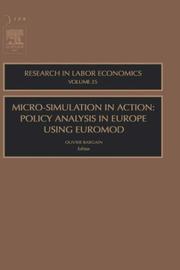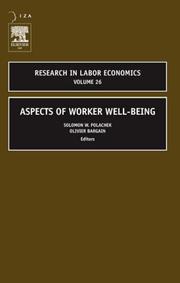| Listing 1 - 8 of 8 |
Sort by
|

ISBN: 0762313471 9780762313471 1849504423 9786610708185 1280708182 008046582X 9781849504423 Year: 2009 Publisher: Bingley Emerald Group Publishing Limited
Abstract | Keywords | Export | Availability | Bookmark
 Loading...
Loading...Choose an application
- Reference Manager
- EndNote
- RefWorks (Direct export to RefWorks)
This volume contains eight contributions aimed to advance policy analysis using the European tax-benefit micro-simulation model, EUROMOD. Microsimulation allows computing the whole set of taxes and benefits of a country and the resulting budget constraint for each household of a representative dataset. Thus, it can be used to evaluate how existing fiscal policies alter inequality, poverty and the overall income distribution. In addition, the simulation of financial incentives considerably improves the econometric estimations of labor supply behaviors, fertility choices, and marital decisions, thereby allowing better prediction to policy changes. EUROMOD goes once step further in the process of helping policy design: based on homogenized datasets and harmonized definitions of tax-benefit instruments, it allows to perform comprehensive international comparisons of EU-15 countries and to evaluate the optimality of tax-benefit policies. For instance, one can assess the effect of a common reform in particular institutional settings or the transmission of a tax-benefit system from one country to another. After an introductory chapter that present the history and the scope of the EUROMOD project, seven chapters on different policy issues follow. Among the discussed themes are: the relevance of the British tax credit to encourage female employment in continental Europe, the impact of hypothetical child benefits on child poverty in Southern Europe, the variety of effects of the same standard pension reform once implemented in different European countries, the role of the fiscal drag as an automatic stabilizer and its effect on labor costs, the revelation of social preferences from actual implicit tax rates. It aims to advance policy analysis using the European Tax-benefit Model. It evaluates how existing fiscal policies alter inequality, poverty and the overall income distribution. It investigates how financial incentives considerably improve the econometric estimations of labor supply behaviors, fertility and matrial choices.
336.2
Book
ISBN: 9782111512092 2111512095 Year: 2018 Publisher: Paris: Institut national de la statistique et des études économiques,
Abstract | Keywords | Export | Availability | Bookmark
 Loading...
Loading...Choose an application
- Reference Manager
- EndNote
- RefWorks (Direct export to RefWorks)
Digital
Abstract | Keywords | Export | Availability | Bookmark
 Loading...
Loading...Choose an application
- Reference Manager
- EndNote
- RefWorks (Direct export to RefWorks)

ISBN: 1281004006 9786611004002 0080475507 9780080475509 9781849504737 1849504733 0762313900 9780762314249 9780762313907 Year: 2007 Publisher: Amsterdam ; Boston : Elsevier JAI,
Abstract | Keywords | Export | Availability | Bookmark
 Loading...
Loading...Choose an application
- Reference Manager
- EndNote
- RefWorks (Direct export to RefWorks)
This volume contains thirteen new and original chapters on topics relating to worker well-being. It deals directly with how economic institutions affect individual and family earnings distributions. Topics covered include job training, worker and firm mobility, unions, collective bargaining, minimum wages, unemployment insurance and schooling. Among the questions answered are: To what extent do greater work hours of women mitigate the widening of the family earnings distribution? To what extent does the decline in unionization widen the distribution of earnings? To what extent do computers expand the earnings distribution? To what extent does the Russian wage distribution change if one accounted for wage arrears? To what extent does business relocation bring about job creation and job destruction? To what extent does maternal education increase childrens education? To what extent do job skills matter for low-income workers? And finally, why do minimum wage increases often fail to lead to increases in unemployment? There are thirteen new and original chapters containing research on aspects of worker well-being. Each chapter is written by experts in the field.
Labor economics. --- Business & Economics --- Labor & Workers' Economics --- Labor economics --- Income distribution --- Wages --- Labor supply --- Work environment --- E-books --- Compensation --- Departmental salaries --- Earnings --- Pay --- Remuneration --- Salaries --- Wage-fund --- Wage rates --- Working class --- Income --- Labor costs --- Compensation management --- Cost and standard of living --- Prices --- Distribution of income --- Income inequality --- Inequality of income --- Distribution (Economic theory) --- Disposable income --- Economics --- Climate, Workplace --- Environment, Work --- Places of work --- Work places --- Working conditions, Physical --- Working environment --- Workplace --- Workplace climate --- Workplace environment --- Worksite environment --- Environmental engineering --- Industrial engineering --- Labor force --- Labor force participation --- Labor pool --- Work force --- Workforce --- Labor market --- Human capital --- Labor mobility --- Manpower --- Manpower policy --- Science --- Labour economics. --- General. --- Income distribution. --- Wages. --- Labor supply. --- Work environment.
Digital
Year: 2011 Publisher: Munich CESifo
Abstract | Keywords | Export | Availability | Bookmark
 Loading...
Loading...Choose an application
- Reference Manager
- EndNote
- RefWorks (Direct export to RefWorks)
Digital
Abstract | Keywords | Export | Availability | Bookmark
 Loading...
Loading...Choose an application
- Reference Manager
- EndNote
- RefWorks (Direct export to RefWorks)
Article
Year: 2010 Publisher: Paris : OECD Publishing,
Abstract | Keywords | Export | Availability | Bookmark
 Loading...
Loading...Choose an application
- Reference Manager
- EndNote
- RefWorks (Direct export to RefWorks)
Macro-level changes can have substantial effects on the distribution of resources at the household level. While it is possible to speculate about which groups are likely to be hardest-hit, detailed distributional studies are still largely backward-looking. This paper suggests a straight forward approach to gauge the distributional and scale implications of large output changes at an early stage. We illustrate the method with an evaluation of the impact of the 2008-2009 crisis in Germany. We take as a starting point a very detailed administrative matched employer-employee dataset to estimate labor demand and predict the effects of output shocks at a disaggregated level. The predicted employment effects are then transposed to household-level micro data, in order to analyze the incidence of rising unemployment and reduced working hours on poverty and inequality. We focus on two alternative scenarios of the labor demand adjustment process, one based on reductions in hours (intensive margin) and close to the German experience, and the other assuming extensive margin adjustments that take place through layoffs (close to the US situation). Our results suggest that the distributional and scale consequences are less severe when labor demand reacts along the intensive margin.
Article
Year: 2010 Publisher: Paris : OECD Publishing,
Abstract | Keywords | Export | Availability | Bookmark
 Loading...
Loading...Choose an application
- Reference Manager
- EndNote
- RefWorks (Direct export to RefWorks)
Macro-level changes can have substantial effects on the distribution of resources at the household level. While it is possible to speculate about which groups are likely to be hardest-hit, detailed distributional studies are still largely backward-looking. This paper suggests a straight forward approach to gauge the distributional and scale implications of large output changes at an early stage. We illustrate the method with an evaluation of the impact of the 2008-2009 crisis in Germany. We take as a starting point a very detailed administrative matched employer-employee dataset to estimate labor demand and predict the effects of output shocks at a disaggregated level. The predicted employment effects are then transposed to household-level micro data, in order to analyze the incidence of rising unemployment and reduced working hours on poverty and inequality. We focus on two alternative scenarios of the labor demand adjustment process, one based on reductions in hours (intensive margin) and close to the German experience, and the other assuming extensive margin adjustments that take place through layoffs (close to the US situation). Our results suggest that the distributional and scale consequences are less severe when labor demand reacts along the intensive margin.
| Listing 1 - 8 of 8 |
Sort by
|

 Search
Search Feedback
Feedback About UniCat
About UniCat  Help
Help News
News